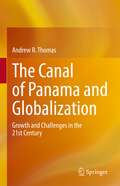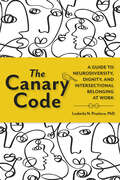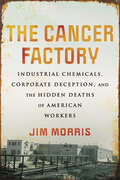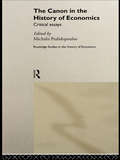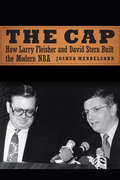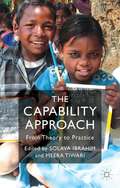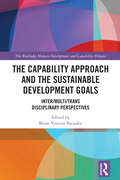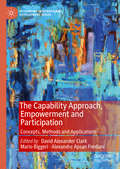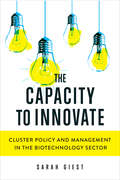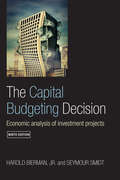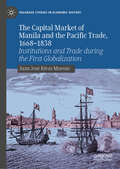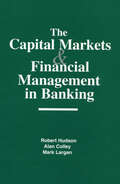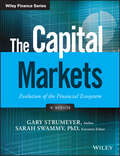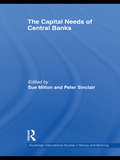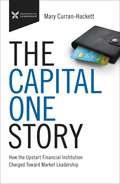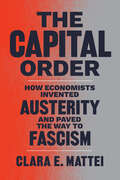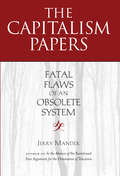- Table View
- List View
The Canal of Panama and Globalization: Growth and Challenges in the 21st Century
by Andrew R. ThomasThis book explores the relationship between the Panama Canal and the evolution of the global economy. It details the role the Canal played in America’s ascendancy and the development of modern globalization. Then, it explores how the Panamanian people have brought the Panama Canal into the 21st Century, making the nation an ever-bigger player in multi-modal transport and international trade. It concludes with a deep dive into the future of globalization and what it ultimately means for the Canal.
The Canary Code: A Guide to Neurodiversity, Dignity, and Intersectional Belonging at Work
by Ludmila N. Praslova, PhDExclusion robs people of opportunities, and it robs organizations of talent. In the long run, exclusionary systems are lose-lose.How do we build win-win organizational systems?From a member of the Thinkers50 2024 Radar cohort of global management thinkers most likely to impact workplaces and the first person to have written for Harvard Business Review from an autistic perspective comes The Canary Code—a guide to win-win workplaces.Healthy systems that support talent most impacted by organizational ills—canaries in the coal mine—support everyone. Currently, despite their skills and work ethics, members of ADHD, autism, Tourette Syndrome, learning differences, and related communities face drastic barriers to hiring and advancement. In the U.S., 30-40% of neurodivergent people and 85% of autistic college graduates struggle with unemployment. Like canaries in the mine, they are impacted by issues that ultimately harm everyone. Lack of flexibility, transparency, and psychological safety excludes neurodivergent, disabled, and multiply marginalized talent—and leaves most employees stressed and disengaged. This unique book is a guide to change-making for CEOs, managers, HR leaders, and everyone who wants to contribute to building a more inclusive world. The authors' over 25 years of experience spanning global diversity to neurodiversity leadership and extensive research on innovative practices of uniquely inclusive organizations around the world inform this books':Explicitly intersectional approach to (neuro)inclusionHolistic understanding of humans and their social, cognitive, emotional, and physical differences. Holistic approach to organizational talent practices, from creating job descriptions and recruiting to onboarding, performance management, and leadership development.A globally inclusive approach that centers, celebrates and invites multiple voices from the neurodivergent community.A lead from where you are approach to change-making.This groundbreaking book combines the lived experience with academic rigor, innovative thought leadership, and lively, accessible writing. To support different types of readers, academic, applied, and lived experience content is clearly identified, helping readers choose their own adventure.
The Cancer Factory: Industrial Chemicals, Corporate Deception, and the Hidden Deaths of American Workers
by Jim Morris&“No journalist knows more about toxic chemicals in the workplace than Jim Morris. The Cancer Factory is the crowning achievement of his estimable career spent walking fence lines, factory floors, and doctor&’s offices.&”—Dan Fagin, author of the Pulitzer Prize–winning Toms River&“The Cancer Factory could not come at a better time, as we reckon with how our bodies pay the price for our nation&’s toxic history and as today&’s workers fight not for only their rights but for their very lives.… A powerful and essential read.&”—Anna Clark, author of The Poisoned CityThe story of a group of Goodyear Tire and Rubber workers fatally exposed to toxic chemicals, the lawyer who sought justice on their behalf, and the shameful lack of protection our society affords all workersWorking at the Goodyear Tire and Rubber Company chemical plant in Niagara Falls, New York, was considered a good job. It was the kind of industrial manufacturing job that allowed blue-collar workers to thrive in the latter half of the 20th century—that allowed them to buy their own home, and maybe a small boat for the lake.But it was also the kind of job that exposed you to toxic chemicals and offered little to no protection from them, either in the way of protective gear or adequate ventilation. Eventually, it was a job that gave you bladder cancer.The Cancer Factory tells the story of the workers who experienced one of the nation&’s worst, and best-documented, outbreaks of work-related cancer, and the lawyer who has represented the bladder-cancer victims at the plant for more than 30 years. Goodyear, and its chemical supplier, DuPont, knew that two of the chemicals used in the plant had been shown to cause cancer, but made little effort to protect the plant&’s workers until the cluster of cancer cases—and deaths—was undeniable.In doing so it tells a broader story of corporate malfeasance and governmental neglect. Workers have only weak protections from exposure to toxic substances in America, and regulatory breaches contribute to an estimated 95,000 deaths from occupational illness each year. Based on 4 decades of reporting and delving deeply into the scientific literature about toxic substances and health risks, the arcana of worker regulations, and reality of loose enforcement, The Cancer Factory exposes the terrible health risks too many workers face.
The Cannabis Business: Understanding Law, Finance, and Governance in America’s Newest Industry
by Charles S. Alovisetti Cassia FurmanAs the largely illicit cannabis market transitions to a legal, regulated industry, the "canna-curious" and experienced industry participants alike are experiencing the harsh truth: Making a fortune in the legal cannabis industry is a challenge made even more difficult by a complex patchwork of state and federal laws. The Cannabis Business clears the confusion around topics such as the distinction between hemp and cannabis and why it matters for consumers and regulators, why CBD isn’t completely legal in the U.S., why and how states differ in their licensing processes, and how deal structuring is impacted by state regulations. Written by attorneys from the nation’s leading cannabis law and policy firm, this comprehensive primer on all things cannabis law is a must-have for anyone seeking to understand the major practical legal issues facing the cannabis industry in the U.S.
The Canny Cook: Freezer & storecupboard meals on a budget
by Phil VickeryNutritious and convenient, canned and frozen food can be used for a wide range of value-for-money recipes. In The Canny Cook, Phil Vickery shows you not only how to spend and waste less, but also cook fast, fuss-free, good-for-you meals that are bursting with flavour. From vegan and vegetarian dishes, to pasta, meat and fish, desserts and healthy snacks, Phil's creative and inspiring recipes are perfect for anyone looking to feed a family using everyday supermarket ingredients.
The Canny Cook: Freezer & storecupboard meals on a budget
by Phil VickeryNutritious and convenient, canned and frozen food can be used for a wide range of value-for-money recipes. In The Canny Cook, Phil Vickery shows you not only how to spend and waste less, but also cook fast, fuss-free, good-for-you meals that are bursting with flavour. From vegan and vegetarian dishes, to pasta, meat and fish, desserts and healthy snacks, Phil's creative and inspiring recipes are perfect for anyone looking to feed a family using everyday supermarket ingredients.
The Canon in the History of Economics: Critical Essays (Routledge Studies In The History Of Economics #Vol. 28)
by Michalis PsalidopoulosThe construction and the role of the economic canon, the accepted list of great works and great authors, has been the subject of much recent literary and historical debate. By contrast, the concept of the canon has been largely dormant in the study of the history of economics, with the canonical sequence of Smith, Ricardo, Marx, etc. constituting t
The Cap: How Larry Fleisher and David Stern Built the Modern NBA
by Joshua MendelsohnToday the salary cap is an NBA institution, something fans take for granted as part of the fabric of the league or an obstacle to their favorite team&’s chances to win a championship. In the early 1980s, however, a salary cap was not only novel but nonexistent. The Cap tells the fascinating, behind-the-scenes story of the deal between the NBA and the National Basketball Players Association that created the salary cap in 1983, the first in all of sports, against the backdrop of a looming players&’ strike on one side and threatened economic collapse on the other. Joshua Mendelsohn illustrates how the salary cap was more than just professional basketball&’s economic foundation—it was a grand bargain, a compromise meant to end the chaos that had gripped the sport since the early 1960s. The NBA had spent decades in a vulnerable position financially and legally, unique in professional sports. It entered the 1980s badly battered, something no one knew better than a few legendary NBA figures: Larry Fleisher, general counsel and negotiator for the National Basketball Players Association; Larry O&’Brien, the commissioner; and David Stern, who led negotiations for the NBA and would be named the commissioner a few months after the salary cap deal was reached. As a result, in 1983 the NBA and its players made a novel settlement. The players gave up infinite pay increases, but they gained a guaranteed piece of the league&’s revenue and free agency to play where they wished—a combination that did not exist before in professional sports but as a result became standard for the NBA, NFL, and NHL as well.The Cap explores in detail not only the high-stakes negotiations in the early 1980s but all the twists and turns through the decades that led the parties to reach a salary cap compromise. It is a compelling story that involves notable players, colorful owners, visionary league and union officials, and a sport trying to solidify a bright future despite a turbulent past and present. This is a story missing from the landscape of basketball history.
The Capability Approach
by Solava Ibrahim Meera TiwariHow can human capabilities be articulated and promoted in practice? How can the challenges encountered in its application be addressed? This volume answers these research questions through nine country case studies from the Global North and the Global South.
The Capability Approach and the Sustainable Development Goals: Inter/Multi/Trans Disciplinary Perspectives (The Routledge Human Development and Capability Debates)
by Brian Vincent IkejiakuThis book demonstrates how the capability approach to human development can contribute to the realisation of the 2015 United Nations Sustainable Development Goals (SDGs).The capability approach dictates that success should not be measured by economic indicators but by people leading meaningful, free, fulfilled, happy, or satisfied lives. Drawing from a range of disciplinary perspectives, this book argues that it is vital that the focus for the SDGs should shift to benefiting the most vulnerable. Case studies from across Asia, Africa, Latin America (Global South), and the United States, the United Kingdom, and Australia (Global North) consider how the capability approach can contribute as a practical framework to achieving the SDGs’ ambitions for social, economic, political, and legal progress.Drawing on insights from a range of disciplines, this book will be of interest to researchers and practitioners from the fields of law, politics, international relations, criminology, international development, sociology, public policy, area studies, and others.
The Capability Approach, Empowerment and Participation: Concepts, Methods and Applications (Rethinking International Development series)
by Mario Biggeri David Alexander Clark Alexandre Apsan FredianiThis book explores the linkages between Amartya Sen’s Capability Approach and participatory forms of development – especially those associated with critical pedagogy and empowerment from the bottom-up. It shows how the capability approach and the participatory movement can complement and reinforce each other helping to ensure that democratic principles are respected and become the foundation for sustainable human development. The Capability Approach provides guiding principles for protecting the transformative roots of participation (safeguarding ownership, accountability and empowerment), while participation delivers vital methods for making the Capability Approach operational. Divided into three overlapping parts that focus on concepts, methods and applications, this work draws on diverse fieldwork experiences to unpack power relations, address adaptive preferences, explore individual and collective agency, consider new partnerships for development, and develop innovative concepts.
The Capability Approach: Development Practice and Public Policy in the Asia-Pacific Region (Routledge Advances in Social Economics #18)
by Francesca Panzironi Katharine GelberThis book provides a unique laboratory of ‘capabilities in practice’ in the Asia-Pacific region. It explores the application of the capability approach in development practice and public policy from a multidisciplinary perspective by bringing together scholars and practitioners from a wide range of disciplinary backgrounds, including development studies, health policy, political science, political theory, political economy, architecture, indigenous studies, urban planning and communication technologies. The first part of the book provides a foundational theoretical framework to introduce the empirical applications of the capability theory in different areas of development practice and public policy in the Asia-Pacific region. This part discusses thorny issues in capability theory and raises the potential for capability theory to lead to new ways of thinking about old problems. The second part discusses the application of the capability approach to intransigent problems of marginalisation and the articulation of public policy in New Zealand and Australia. In particular, this part focuses on the potential implications that a capability-based approach can have on the well-being of indigenous peoples in both countries, as well as children, older renters, and urban dwellers in Australia. The third part elucidates how capability theory is being applied by researchers in the Asia-Pacific region to local issues in developing countries such as Samoa, Vanuatu, Papua New Guinea and Sri Lanka. In doing so, it provides original content to the world market in capability theory by focussing on this often-neglected area of scholarship. As a whole, this volume offers a unique and innovative scrutiny of a multifaceted capability-based analysis of development practice and public policy. The scope and breadth of this volume advance the application of the capability approach and offer an indispensable resource to scholars, researchers, policy makers and policy practitioners interested in the theoretical insights and practical implications of the capability approach.
The Capacity of Local Governments in Europe: Autonomy, Responsibilities and Reforms (Governance and Public Management)
by Sabine Kuhlmann Benoît Paul Dumas Moritz HeubergerThis book compares local self-government in Europe. It examines local institutional structures, autonomy, and capacities in six selected countries - France, Italy, Sweden, Hungary, Poland, and the United Kingdom - each of which represents a typical model of European local government. Within Europe, an overall trend towards more local government capacities and autonomy can be identified, but there are also some counter tendencies to this trend and major differences regarding local politico-administrative settings, functional responsibilities, and resources. The book demonstrates that a certain degree of local financial autonomy and fiscal discretion is necessary for effective service provision. Furthermore, a robust local organization, viable territorial structures, a professional public service, strong local leadership, and well-functioning tools of democratic participation are key aspects for local governments to effectively fulfill their tasks and ensure political accountability. The book will appeal to students and scholars of Public Administration and Public Management, as well as practitioners and policy-makers at different levels of government, in public enterprises, and in NGOs.
The Capacity to Innovate: Cluster Policy and Management in the Biotechnology Sector (Studies in Comparative Political Economy and Public Policy)
by Sarah GiestIn The Capacity to Innovate, Sarah Giest provides insight into the collaborative and absorptive capacities needed to provide public support to local innovation through cluster organizations. The book offers a detailed view of the vertical, multi-level, and horizontal dynamics in clusters and cluster policy and addresses how they are managed and supported. Using the biotechnology field as an example, Giest highlights challenges in the collaborative efforts of public bodies, private companies, and research institutes to establish a successful ecosystem of innovation in this sector. The book argues that cluster policy in collaboration with cluster organizations should focus on absorptive and collaborative capacity elements missing in the cluster context in order to improve performance. Currently, governments operate at different levels – from the local to the supranational – in order to support clusters, and cluster policies are often pursued alongside other programs, leading to uncoordinated efforts and ineffective cluster strategies. The Capacity to Innovate advocates for a coordinated effort by government and cluster organizations to support capacity elements lacking within the specific cluster context.
The Capital Asset Pricing Model in the 21st Century
by Haim LevyThe Capital Asset Pricing Model (CAPM) and the mean-variance (M-V) rule, which are based on classic expected utility theory, have been heavily criticized theoretically and empirically. The advent of behavioral economics, prospect theory and other psychology-minded approaches in finance challenges the rational investor model from which CAPM and M-V derive. Haim Levy argues that the tension between the classic financial models and behavioral economics approaches is more apparent than real. This book aims to relax the tension between the two paradigms. Specifically, Professor Levy shows that although behavioral economics contradicts aspects of expected utility theory, CAPM and M-V are intact in both expected utility theory and cumulative prospect theory frameworks. There is furthermore no evidence to reject CAPM empirically when ex-ante parameters are employed. Professionals may thus comfortably teach and use CAPM and behavioral economics or cumulative prospect theory as coexisting paradigms.
The Capital Budgeting Decision, Ninth Edition: Economic Analysis of Investment Projects
by Harold Bierman Jr. Seymour SmidtFully updated and revised by international authorities on the topic, this new version of a classic and established text returns to its roots as a clear and concise introduction to this complex but essential topic in corporate finance. Retaining the authority and reputation of previous editions, it now covers several topics in-depth which are frequently under explored, including distribution policy and capital budgeting. Features new to this edition include: a new chapter on real options new material on uncertainty in decision-making. Easily understandable, and covering the essentials of capital budgeting, this book helps readers to make intelligent capital budgeting decisions for corporations of every type.
The Capital Market of Manila and the Pacific Trade, 1668-1838: Institutions and Trade during the First Globalization (Palgrave Studies in Economic History)
by Juan José Rivas MorenoEconomic history has always emphasized the importance of long-distance trade in the emergence of modern financial markets, yet almost nothing is known about the Manila trade. This book offers the first reconstruction of the capital market of Manila using new archival sources that have never been used in the economic history of Pacific trade. The book explains how trade between Asia and Spanish America across the Pacific, which lasted for 250 years (1571 – 1815) was financed from the city of Manila.The book analyses the political economy and institutional structures of the Manila capital market in the context of the global silver trade, as well as addressing key similarities and differences with European trade routes and differing approaches to colonialism and commerce in Asian waters. It traces how the Manila capital market emerged in a bottom-up process with a redistributive aspect that tied the interests of citizens with the fortunes of trade, using institutions familiar to the public like legacy funds, brotherhoods and lay religious orders to pool liquidity, originate working capital, and internalise the risk of loss at sea. It challenges the notion that there is a normative model for the development of capital markets and introduces an industrial organisation analysis to the broader structure of Early Modern trade in the Spanish Empire. Sitting at the intersection of economic and financial history, global history, imperial history and political economy, this book will be a cutting-edge and valuable resource for a broad range of scholars.
The Capital Markets and Financial Management in Banking
by Robert Hudson Alan Colley Mark LarganFirst published in 2000. Routledge is an imprint of Taylor & Francis, an informa company.
The Capital Markets of Emerging Europe: Institutions, Instruments and Investors
by Li Lian Ong Silvia IorgovaA report from the International Monetary Fund.
The Capital Markets: Evolution Of The Financial Ecosystem (Wiley Finance Ser.)
by Gary Strumeyer Sarah SwammyThe Capital Markets: evolution of the financial ecosystem is the new standard providing practical text book style coverage of this dynamic market and its products. Written by the former President of BNY Mellon Capital Markets, LLC for both financial professionals and novices, The Capital Markets provides a comprehensive macro view of the marketplace and how its products operate. This book is the definitive resource and the companion text to The Capital Markets website. The subject matter offers an authoritative discussion of the fundamentals of both, the fixed income and equity markets, underwriting, securitizations, derivatives, currency among other products through the lens of leading industry practitioners. Key Learning Concepts Understand the impact of both global and domestic regulatory changes Learn about the products that holistically make up the capital markets Explore the components of the infrastructure that underpins these markets Examine the tools used for trading and managing risk Review new product innovations
The Capital Needs of Central Banks (Routledge International Studies In Money And Banking Ser. #61)
by Sue MiltonCentral banks have evolved over many years, and sometimes centuries, as policy-making, not profit-making, institutions, and yet they are structured legally and financially like ‘for-profit’ companies of the twenty-first century. The question is what is an appropriate level of equity, or capital, for a central bank to have so that it can function for policy effectiveness over profit-maximisation, without hindrance to the achievement and maintenance of policy goals? This collection takes the reader through historical, theoretical and factual discussions on why central banks exist and the role – actual and intended – they have in assisting their home nation in achieving monetary and financial stability. The contributions analyse the different ways central banks are funded and how funding arrangements may impact on their independence. The objective is to explore these themes first from the academic and practitioner’s views – those of the economist, accountant and lawyer’s – and then to introduce practical experiences from a range of different central banks, in terms of their economic and socio-political environments. It will be the first time that the theorist and practitioner, the accountant, the economist and the lawyer come together in one volume. The reader will be able to access the full breadth of views on this important subject. The main observations are that there is no single, quantifiable formula that central banks can use to calculate capital levels. Factors to consider are the historical context of central banks and whether capital was ever appropriate to needs at their foundation; the cultural, social and political contexts; and, in terms of the presentation of financial statements, profit and loss sharing arrangements and what accounting conventions are being used. If these are considered alongside the, often idiosyncratic, mandates individual central banks have, a qualitative understanding of what is an appropriate level of capital is achieved. This collection will be of interest to postgraduates and researchers focusing on the role of central banks in monetary economics; as well as a professional audience of central bankers, the BIS, the IMF, World Bank, EBRD and government departments.
The Capital One Story: How the Upstart Financial Institution Charged Toward Market Leadership (The Business Storybook Series)
by Mary Curran HackettWhat can you learn from the most successful companies in the world? The Capital One Story will help you understand and adopt the competitive strategies, workplace culture, and daily business practices that enabled an unlikely credit card startup to revolutionize the credit industry.After twenty-five years in the credit card business, Capital One has earned its place in wallets across the world. When the company&’s two young founders set out to individualize credit, the financial world thought they were crazy…until it was clear that they weren&’t.Working in the banking industry, Richard Fairbank and Nigel Morris saw that the one-size-fits all standard that the credit card companies employed was leaving big money on the table. They cracked the code and figured out how to customize the credit card experience by offering personalized designs, credit limits, and rewards, revolutionizing the way the credit card industry operated.Known for their ubiquitous advertising campaigns with A-list talent such as Jennifer Garner and Samuel L. Jackson, the youngest bank in the business was once turned down by every one of their competitors but has since grown to dominate the industry.Through the story of Capital One, you&’ll learn:How to recognize underserved sections of a market.How rejection by every company in the business doesn&’t mean it&’s time to quit.How to determine what people want and how to get it to them.How to employ marketing campaigns that will change the way people live.Discover how this iconic organization got it right and created a successful long-lasting business, and how you can do the same for your company.
The Capital Order: How Economists Invented Austerity and Paved the Way to Fascism
by Clara E. Mattei"A must-read, with key lessons for the future."—Thomas Piketty A groundbreaking examination of austerity’s dark intellectual origins. For more than a century, governments facing financial crisis have resorted to the economic policies of austerity—cuts to wages, fiscal spending, and public benefits—as a path to solvency. While these policies have been successful in appeasing creditors, they’ve had devastating effects on social and economic welfare in countries all over the world. Today, as austerity remains a favored policy among troubled states, an important question remains: What if solvency was never really the goal? In The Capital Order, political economist Clara E. Mattei explores the intellectual origins of austerity to uncover its originating motives: the protection of capital—and indeed capitalism—in times of social upheaval from below. Mattei traces modern austerity to its origins in interwar Britain and Italy, revealing how the threat of working-class power in the years after World War I animated a set of top-down economic policies that elevated owners, smothered workers, and imposed a rigid economic hierarchy across their societies. Where these policies “succeeded,” relatively speaking, was in their enrichment of certain parties, including employers and foreign-trade interests, who accumulated power and capital at the expense of labor. Here, Mattei argues, is where the true value of austerity can be observed: its insulation of entrenched privilege and its elimination of all alternatives to capitalism. Drawing on newly uncovered archival material from Britain and Italy, much of it translated for the first time, The Capital Order offers a damning and essential new account of the rise of austerity—and of modern economics—at the levers of contemporary political power.
The Capital Order: How Economists Invented Austerity and Paved the Way to Fascism
by Clara E. Mattei"A must-read, with key lessons for the future."—Thomas Piketty A groundbreaking examination of austerity’s dark intellectual origins. For more than a century, governments facing financial crisis have resorted to the economic policies of austerity—cuts to wages, fiscal spending, and public benefits—as a path to solvency. While these policies have been successful in appeasing creditors, they’ve had devastating effects on social and economic welfare in countries all over the world. Today, as austerity remains a favored policy among troubled states, an important question remains: What if solvency was never really the goal? In The Capital Order, political economist Clara E. Mattei explores the intellectual origins of austerity to uncover its originating motives: the protection of capital—and indeed capitalism—in times of social upheaval from below. Mattei traces modern austerity to its origins in interwar Britain and Italy, revealing how the threat of working-class power in the years after World War I animated a set of top-down economic policies that elevated owners, smothered workers, and imposed a rigid economic hierarchy across their societies. Where these policies “succeeded,” relatively speaking, was in their enrichment of certain parties, including employers and foreign-trade interests, who accumulated power and capital at the expense of labor. Here, Mattei argues, is where the true value of austerity can be observed: its insulation of entrenched privilege and its elimination of all alternatives to capitalism. Drawing on newly uncovered archival material from Britain and Italy, much of it translated for the first time, The Capital Order offers a damning and essential new account of the rise of austerity—and of modern economics—at the levers of contemporary political power.
The Capitalism Papers: Fatal Flaws of an Obsolete System
by Jerry ManderIn the vein of his bestseller, Four Arguments for the Elimination of Television, nationally recognized social critic Jerry Mander researches, discusses, and exposes the momentous and unsolvable environmental and social problem of capitalism.Mander argues that capitalism is no longer a viable system: "What may have worked in 1900 is calamitous in 2010." Capitalism, utterly dependent on never-ending economic growth, is an impossible absurdity on a finite planet with limited resources. Climate change, together with global food, water, and resource shortages, are only the start.Mander draws attention to capitalism's obsessive need to dominate and undermine democracy, as well as to diminish social and economic equity. Designed to operate free of "morality," the system promotes "permanent war" as a key economic strategy. Worst of all, the problems of capitalism are intrinsic to the form. Many organizations are already anticipating the breakdown of the system and are working to define new hierarchies of democratic values that respect the carrying capacities of the planet.
